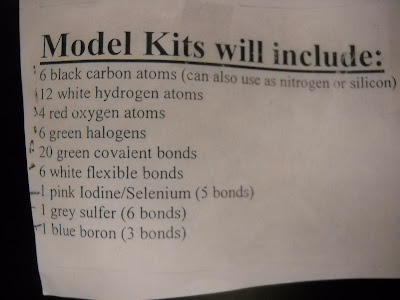










We are trying to familiarize ourselves with Lewis structures. To do this, we are building models with plastic tubes and balls.
Our hypothesis is that we will become better at building models using the given materials. Also, we will be able to draw Lewis structures better.
Materials
1. Small balls—(hydrogen, fluorine, etc.)
2. Long tubes—connectors
3. Paper towels
4. Camera
5. Pencil #2
There are not really any safety concerns in this lab. We are working with safe, fun, and easy modeling kits.
Procedure
1. Build a model for each of the molecules listed on the table on the Lab page.
2. Draw a 3-D structure of each molecule and record it into a table. Use solid lines to represent bonds in the plane of the paper, dashed lines for bongs that point back from the plane of the paper, and wedged lines for bonds that point out from the plane of the paper toward the viewer.
3. Determine the shape of the molecule.
4. Find the bond angle for each molecule.
5. Determine whether each molecule is polar or if it has a resonance structure.
6. Take pictures of the models you made along with a paper towel that says which Lewis structure it is.
Results
We found out that by building molecules, we get more acquainted with the bonds and repelling groups. The photography and lewis structures (above) are just a few of the many models that we put together. By comparing these lewis structures to the actual models, we are able to make more connections between the repelling groups (dots in Lewis structures) and bonds (lines in the Lewis structures).
Conclusion
We accept our hypothesis because we did indeed learn how to construct models and draw Lewis structures better.
We learned that to become better at understanding hard concepts, you need to look at the situation from different angles. Not only did we draw Lewis structures constantly, we also built models. This could be applied to any real life situation.
The only errors we could have made were drawing the Lewis structures wrong or constructing the models incorrectly.
Our hypothesis is that we will become better at building models using the given materials. Also, we will be able to draw Lewis structures better.
Materials
1. Small balls—(hydrogen, fluorine, etc.)
2. Long tubes—connectors
3. Paper towels
4. Camera
5. Pencil #2
There are not really any safety concerns in this lab. We are working with safe, fun, and easy modeling kits.
Procedure
1. Build a model for each of the molecules listed on the table on the Lab page.
2. Draw a 3-D structure of each molecule and record it into a table. Use solid lines to represent bonds in the plane of the paper, dashed lines for bongs that point back from the plane of the paper, and wedged lines for bonds that point out from the plane of the paper toward the viewer.
3. Determine the shape of the molecule.
4. Find the bond angle for each molecule.
5. Determine whether each molecule is polar or if it has a resonance structure.
6. Take pictures of the models you made along with a paper towel that says which Lewis structure it is.
Results
We found out that by building molecules, we get more acquainted with the bonds and repelling groups. The photography and lewis structures (above) are just a few of the many models that we put together. By comparing these lewis structures to the actual models, we are able to make more connections between the repelling groups (dots in Lewis structures) and bonds (lines in the Lewis structures).
Conclusion
We accept our hypothesis because we did indeed learn how to construct models and draw Lewis structures better.
We learned that to become better at understanding hard concepts, you need to look at the situation from different angles. Not only did we draw Lewis structures constantly, we also built models. This could be applied to any real life situation.
The only errors we could have made were drawing the Lewis structures wrong or constructing the models incorrectly.






